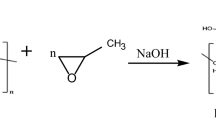Abstract
Hydroxypropyl guar gum (HPGG), polyacrylamide (PAM) and carboxymethyl cellulose (CMC) are widely used as thickeners in fracturing fluids, and thus contaminate wastewater. We designed a clean oxidation process for the treatment of waste fracturing fluids containing hydroxypropyl guar gum and other polymers under high pH value. For that, 1,10-phenanthroline(L)-transition metal complexes were prepared and screened for viscosity reduction of hydroxypropyl guar gum oxidized by hydrogen peroxide (H2O2). Results show that Cu(II)L exhibited high catalytic performance for the degradation of hydroxypropyl guar gum in a pH range of 7–14. Under the optimum experimental conditions, the viscosity of hydroxypropyl guar gum solution can be reduced effectively with 10.0% H2O2 and 5.0% Cu(II)L. The chemical oxygen demand (COD) of the hydroxypropyl guar gum solution decreased from 8 g/L to 65 mg/L. Cu(II)L also showed a high catalytic ability for the degradation of various polymers.




Similar content being viewed by others
References
Bautista P, Mohedano AF, Casas JA (2008) An overview of the application of Fenton oxidation to industrial wastewaters treatment. J Chem Technol Biotechnol 83(10):1323–1338
Botlík O (2006) Use of Fenton oxidation to improve the biodegradability of a pharmaceutical wastewater. J Hazard Mater 136(2):258–265
Ensing B, Buda F, Baerends EJ (2003) Fenton-like chemistry in water: oxidation catalysis by Fe(III) and H2O2. Cheminform 34(43):5722–5731
Flory PJ, Fox TG (1951) Treatment of intrinsic viscosities. J Am Chem Soc 73(5):1904–1908
Gu H, Tang X, Hong RY (2013) Ubbelohde viscometer measurement of water-based Fe3O4, magnetic fluid prepared by coprecipitation. J Magn Magn Mater 348(12):88–92
Lee HS, Park SJ, Tai IY (2002) Wastewater treatment in a hybrid biological reactor using powdered minerals: effects of organic loading rates on COD removal and nitrification. Process Biochem 38(1):81–88
Lu M, Wei X (2011) Treatment of oilfield wastewater containing polymer by the batch activated sludge reactor combined with a zerovalent iron/EDTA/air system. Biores Technol 102(3):2555–2562
Lu MC, Lin CJ, Liao CH (2001) Influence of pH on the dewatering of activated sludge by Fenton’s reagent. Water Sci Technol 44(10):327–332
Meriç S, Kaptan D, Olmez T (2004) Color and COD removal from wastewater containing Reactive Black 5 using Fenton’s oxidation process. Chemosphere 54(3):435–441
National Standard of the Peoples Republic of China GB 18918 (2002) Integrated wastewater discharge standard
National Standard of the Peoples Republic of China GB/T 15456 (2008) Determination of chemical oxygen demand
Netopilík M, Bohdanecký M (1995) Ubbelohde viscometer modified for foaming solutions of water soluble polymers. Eur Polym J 31(3):289–290
Neyens E, Baeyens J (2003) A review of classic Fenton’s peroxidation as an advanced oxidation technique. J Hazard Mater 98(1–3):33–50
Pandit B (2017) Biodegradable guar gum based hydrogel for pharmaceutical application. Curr Chem Biol 11(1):1–7
Shen YF, Tang J, Nie ZH (2009) Tailoring size and structural distortion of Fe3O4 nanoparticles for the purification of contaminated water. Biores Technol 100(18):4139
Silva SSD, Chiavone-Filho O, Neto ELDB (2015) Oil removal from produced water by conjugation of flotation and photo-Fenton processes. J Environ Manag 147(1):257–263
Wang WJ, Chen QH, Li Q, Sheng Y, Zhang XJ, Uvdal K (2012) Ligand-structure effect on the formation of one-dimensional nanoscale Cu(II)-schiff base complexes and solvent-mediated shape transformation. Cryst Growth Des 12:2707–2713
Wu X, Ye Y, Chen Y (2010) Selective oxidation and determination of the substitution pattern of hydroxypropyl guar gum. Carbohyd Polym 80(4):1178–1182
Yu K, Wong D, Parasrampuria J (1996) Guar gum. Anal Profiles Drug Subst Excip 24:243–276
Zhang WX (2003) Nanoscale iron particles for environmental remediation: an overview. J Nanopart Res 5(3–4):323–332
Zhang J, Yang P, Gu X (2017) Catalytic oxidation of hydroxyethyl guar gum by 1, 10-phenanthroline metal complex under high pH. Oilfield Chem 34(3):543–546 and 550
Acknowledgements
This work was financially supported by State Key Laboratory of Petroleum Pollution Control (21763030), Scientific Research Program Funded by Shaanxi Provincial Education Department (17JS114) (17JK0664) and the Open Project Program of State Key Laboratory of Petroleum Pollution Control, CNPC Research Institute of Safety and Environmental Technology. Xi’an science and technology project (201805038YD16CG22(3)).
Author information
Authors and Affiliations
Corresponding authors
Rights and permissions
About this article
Cite this article
Tang, Y., Ren, H., Yang, P. et al. Treatment of fracturing fluid waste by Fenton reaction using transition metal complexes catalyzes oxidation of hydroxypropyl guar gum at high pH. Environ Chem Lett 17, 559–564 (2019). https://doi.org/10.1007/s10311-018-0805-9
Received:
Accepted:
Published:
Issue Date:
DOI: https://doi.org/10.1007/s10311-018-0805-9




